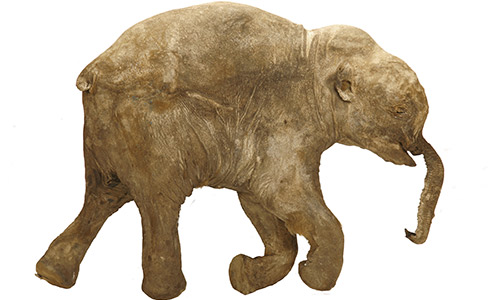
CHICAGO — In a fascinating 2007 discovery, after 40,000 years of being preserved in the frozen soil of the Arctic, a Siberian reindeer herder and his two sons accidentally found an intact baby woolly mammoth. The baby mammoth, now called Lyuba (pronounced Lee-OO-bah) after the herder’s wife, is an incredible specimen and will be at the center of The Field Museum’s new exhibit, “Mammoths and Mastodons: Titans of the Ice Age,” which opens here March 5 and is scheduled to run through Sept. 6, 2010.
Lyuba discovery is providing researchers new windows into the world of the Ice Age times.
“The most special aspect about Lyuba is that she is the most complete woolly mammoth ever to be found,” said exhibition developer Franck Mercurio. “She is 98 percent complete,” he told the World by phone Oct. 1.
Mercurio said Lyuba was only about 30 days old when she died of suffocation after being trapped in mud along the steep banks of a river. While she struggled to free herself, her trunk filled with silt and her body was quickly covered by sediment, he said.
“She was in really good health when she accidentally died,” noted Mercurio.
The baby mammoth weighs approximately 110 pounds and is 45 inches long, and is in excellent condition. She could have been up to 12 feet tall had she lived, Mercurio speculates.
Her appearance at The Field Museum marks her first display in the U.S. The exhibit will include her preserved body along with CT scans and other scientific evidence that confirms existing theories about her species along with new insights.
“We are very excited to be the first to display Lyuba in America,” said Mercurio.
Since her discovery Lyuba’s body has been studied exhaustively in Russia and Japan and she has made headlines around the world. She also starred in a National Geographic documentary.
An international team of scientists performed DNA analysis and an autopsy and used computerized X-ray tomography and microsampling techniques to explore Lyuba’s anatomy and physiology. Previously, the researchers had worked together for more than a decade examining fossils, tusks, and other frozen mammoth carcasses found in Siberia.
They say Lyuba is by far the best-preserved specimen they have ever seen.
Scientists were able to look inside Lyuba’s stomach and found traces of her mother’s milk, said Mercurio. They also found traces of her mother’s fecal matter in her stomach, he said. Elephants today feed their feces to their babies and evidence shows that mammoth behavior was quite similar, noted Mercurio.
Mercurio added that Lyuba is helping scientists to do a series of genetic studies creating material to come up with a mammoth genome, which will allow them to have a complete picture of the mammoth’s DNA sequence or DNA building blocks. Right now they are about 70 percent there, he said.
For millions of years mammoths and mastodons lived in temperate climates and on the wind-swept lands of the frozen north, says the museum. They were great beasts weighing as much as 8 tons and bearing tusks up to 16 feet long. Mammoths ranged in size -some were up to 14-feet tall, while others were as small as a horse. They successfully thrived during the Ice Age and were a source of food and artistic inspiration for ancient peoples who lived in Europe, Asia,and North America. But despite their size and ability to adapt to different habitats, mammoths and mastodons, early cousins of the elephant ,went extinct – leaving scientists an abundant fossil record.
“This exhibit will be a virtual tour around the world and through time,” said Mercurio. The 7,500-square-foot exhibition brings to life how these animals lived and their interactions with ancient humans, he said.
Museum visitors will have the opportunity to better understand how life was during the Ice Age, with large-scale projections, walk-through dioramas, and virtual experiences. Large fleshed-out creatures and skeletons will be featured and visitors will be able to touch and examine them up close.
The exhibit will explore how these creatures lived, forming herds similar in social structure to those of modern elephants. Like elephants, mammoths mostly fed off the grasslands like cows and horses, said Mercurio.
Daniel C. Fisher, lead curator of the exhibition and professor of geological sciences at the University of Michigan, said in a press release, “There’s a visceral awe that takes hold of you in looking at specimen like Lyuba, and the exhibition as a whole demonstrates how close we can come to knowing what these animals were like.” Fisher noted, “These are concrete examples of the extinction process that threatens animals that we know today -animals we would hate to lose.”
After its debut at The Field Museum, the exhibit will embark on a 10-city tour including plans for two international venues.
Photo courtesy of The Field Museum.











Comments